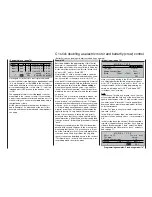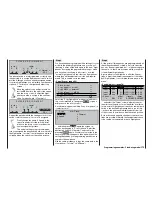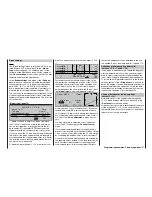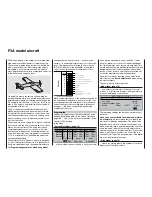
177
Programming examples: Fixed-wing model
Start the programming of the model in a free model
memory: move to the »
Base setup model
« menu,
enter the model name and select your preferred stick
mode and the type of receiver installed in the model.
In the menu …
»Model type« (Seite 70)
SEL
Offset
+100%
2 AIL 2 FL
M O D E L T Y P E
Tail type
Aileron/camber flaps
Brake
Input 1
Normal
Motor on C1
None
… leave “Motor on C1” to “none” and the tail type at
“normal”. However, you must set “2 AIL 2 FL” in the
“Ailerons / camber fl aps” line for this model confi gura-
tion. In the “Brake” line set or leave “Input 1”, because
the associated C1 stick is to be used as the transmit-
ter control for operating the two airbrake servos con-
nected to receiver sockets 1 + 8.
The Offset value defi nes the neutral position of all the
mixers in the “Brake settings” sub-menu of the »
Wing
mixers
« menu. Place this neutral point at about
+90%; this assumes that the airbrakes are to be re-
tracted at the forward position of the C1 stick. The re-
minder of the travel between 90% and the full travel of
the stick (100%) is then an intentional dead zone with
these two mixers; this ensures that the control sur-
faces affected by the mixers set up in the “Brake set-
tings” menu remain in their “normal” position even if
the C1 stick is moved slightly away from its end-point.
At the same time the effective travel of the transmitter
control is automatically expanded back to 100%.
In the menu …
»Control adjust« (page 78)
… assign a switch to the
fl ight phase independent
in-
put 9 for operating the aero-tow release. The travel of
the control for triggering the switch can be adjusted
using the “-” column.
0%
+
100%+100% 0.0 0.0
0% +100%+100% 0.0 0.0
0% +100%+100% 0.0 0.0
0% +100%+100% 0.0 0.0
SYM ASY
ASY
SYM
SEL
SEL
«normal »
7
12
11
10
9
offset
–time+
Input
Input
Input
Input
free
free
free
–
Pressing the
HELP
button with the rotary control
pressed in now takes you to the »
Servo display
«,
where you can check the effect of these settings.
Since the C1 control is required to operate servo 8
as well as servo 1, this link must be created using the
»
Control adjust
« and »
Receiver output swap
« me-
nus.
Move at fi rst to the line for the
fl ight phase indepen-
dent
“input 10” and assign “transmitter control 1” to it
as follows:
0%
+
100%+100% 0.0 0.0
Cnt. 1
0% +100%+100% 0.0 0.0
0% +100%+100% 0.0 0.0
0% +100%+100% 0.0 0.0
SYM ASY
ASY
SYM
SEL
SEL
«normal »
7
12
11
10
9
offset
–time+
Input
Input
Input
Input
free
free
–
With this stage complete, move to the menu …
»Receiver output swap« (page 153)
SEL
7
7
9
8
8
9
10
10
S e r v o
S e r v o
S e r v o
S e r v o
R E C E I V E R O U T P U T
O u t p u t
O u t p u t
O u t p u t
O u t p u t
… and swap over servos 8 and 10, so that the signal
for servo 10 is present at (receiver) output 8, and that
for servo 8 at output 10. For more details on this pro-
cedure please turn to the section entitled “Servos run-
ning in parallel” on page 172.
The travels, and – if necessary – the direction of ro-
tation of the airbrake servo 1 and the second airbra-
ke servo, which still constitutes servo 10 as far as the
transmitter’s internal processing is concerned, can be
adjusted in the menu …
»Servo adjustment« (page 74)
Servo 1
=>
0% 100% 100% 150% 150%
Servo 2 =>
0% 100% 100%
150% 150%
Servo 3 =>
0% 100% 100%
150% 150%
Servo 4 =>
0% 100% 100%
150% 150%
Rev
SEL
SYM ASY
SYM ASY
cent. – travel
+
– limit +
SEL
In the multi-fl ap menu of the menu …
»Wing mixers« (page 110)
… you should now enter the fi rst mixer values for the
four wing fl aps (two ailerons and two fl aps):
+100%
+ 60%
Diff.
+ 50%
+ 30%
0%
0%
0%
0% +100% +100%
0% 0%
0%
0%
AILE
SEL
SEL
+100%
FLAP
+ 60%
AI
Ail–tr
Fl.pos
FL
El–>Fl
Note:
The parameter values shown in this example will vary
from model to model, and will need to be optimised in
the course of a fl ight testing programme.
In the line …
Ai
:
… you defi ne the extent in percentage
terms to which the two pairs of control sur-
faces “AILE” and “FLAP” are to
follow the ai-
leron control system
. When setting the para-
Summary of Contents for mx-24s
Page 1: ...1...
Page 19: ...19 For your notes...
Page 35: ...35 For your notes...
Page 41: ...41 41 For your notes...
Page 57: ...57 For your notes...
Page 63: ...63 63 For your notes...
Page 69: ...69 69 For your notes...
Page 85: ...85 85 For your notes...
Page 99: ...99 For your notes...
Page 143: ...143 For your notes...
Page 191: ...191 For your notes...
Page 212: ...212 212 For your notes...
Page 213: ...213 213 For your notes...
Page 214: ...214 For your notes...
Page 216: ...216...






























